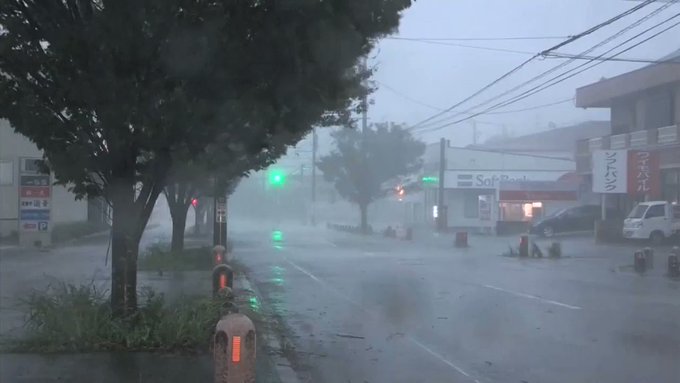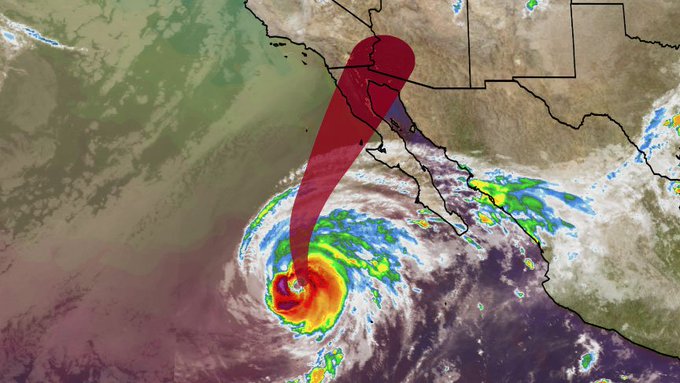Wild weather: Hurricanes, tsunamis and quakes threaten millions
A POWERFUL series of quakes, hurricanes, tsunamis and other storm systems are rattling the globe in the wake of almost a thousands deaths in Indonesia.

A MONSTER typhoon has started to thrash Japan, and a hurricane is on track to wreak havoc in Mexico as Indonesia struggles in the aftermath of a catastrophic tsunami which killed at least 830 people.
There are fears that the natural events could spell disaster for more vulnerable people after a magnitude 7.5 earthquake created a tsunami that formed a wall of water as high as six metres, in Indonesia, on Friday evening.
One of the hardest hit areas was the city of Palu on Sulawesi island, where more than 830 people have been confirmed dead and many more injured. But officials fear the death toll could climb much higher. Hundreds more people are believed to be buried underneath the expansive rubble of collapsed buildings.
Voices that could earlier be heard screaming for help from people trapped below are slowly fading out, according to local reports. Authorities are scrambling to rescue survivors but are faced with severe challenges including a lack of equipment and hard-to-reach areas.
As rescue teams battled the conditions on Sunday to save as many people as possible, a powerful typhoon sliced through Japan after making landfall in the evening. Typhoon Trami has killed at least two people and injured dozens, halting transport, and bringing fierce winds and torrential rain to areas already battered by a string of recent extreme weather episodes.
About 36,000 people were taking shelter in temporary evacuation centres as Trami crossed Japan overnight with strong winds and heavy rains after making landfall around the western city of Tanabe at 9pm (AEST) on Sunday, Kyodo News reported.
The storm could also generate waves up to 11 metres high around the Kanto region, the agency added.
Typhoon Trami sparked travel disruption in the world’s third-biggest economy, with bullet train services suspended, more than 1,000 flights cancelled and Tokyo’s evening train services scrapped.
National broadcaster NHK reported that one man had died in Tottori prefecture on Honshu island and another on in the central city of Fujiyoshida.
At least 84 people suffered minor injuries, many hurt by windows shattered in the driving wind, and one woman in her 60s was reported missing amid fears she was swept into a gutter.
After pummelling Japan’s outlying islands including Okinawa, the storm made landfall south of the city of Osaka in the western part of the country about 8pm local time.

Bodies of tsunami victims in Palu, on Sulawesi island, Indonesia, on September 29, 2018. Picture: Ola Gondronk / AFP.Source:AFP

A tsunami swept away buildings and killed hundreds on the Indonesian island of Sulawesi. Picture: AP/Tatan Syuflana.Source:AP
An official in the town of Shirahama near where Trami made landfall, Yuji Ueno, told AFP the winds were “enormous” and made it impossible to venture outside.
“We saw incredible winds and rain. I stepped outside the city hall in the afternoon, and the rain was swirling in very strong wind. Enormous wind,” Ueno said. “It was difficult to stay standing. It was very scary.”
Trami, which at its height packed maximum gusts of 216km/h, was expected to churn over most of the archipelago, weakening slightly but causing extreme weather into Monday, forecasters said.
Weather officials have warned of potential flooding and landslides and non-compulsory evacuation advisories have been issued to around four million residents, according to public broadcaster NHK.
More than 750,000 households, mainly in western Japan have lost power, according to local utilities and mobile phone services suffered disruption.
As the typhoon barrelled east, rail authorities took the highly unusual step of cancelling evening train services in Tokyo, one of the world’s busiest networks, urging passengers to shelter indoors when the storm hits.
The typhoon did not hit the capital head-on but Tokyo still saw fearsome winds and lashing rain later Sunday and the streets of one of the world’s biggest cities were deserted.
At the world-famous crossing in Shibuya, where thousands normally jostle every few minutes as the lights change, just a few hardy souls braved the horizontal rain and powerful gusts.
Shops and business closed early as the capital hunkered down for the storm.
Trami is the latest in a string of extreme natural events in Japan, which has suffered typhoons, flooding, earthquakes and heatwaves in recent months, claiming scores of lives and causing extensive damage.

Typhoon Trami off the Japanese South Coast in the Philippine Sea on September 27, 2018. Picture: AFP.Source:AFP

A vessel tilts as it ran ashore at a pier as a typhoon approached Yonabaru, Okinawa prefecture, southern Japan on September 29, 2018. Picture: AP.Source:AP
The city of Osaka lay close to the path of the storm and its Kansai Airport, which is situated on reclaimed land offshore and suffered extensive damage in a storm earlier in September, closed early as a precaution.
Officials piled up sandbags to avoid a repeat of flooding seen during the previous storm.
Speaking to AFP from a hotel near the airport, British businessman Richard Swart said: “It’s actually quite warm outside, very windy and with very heavy rain.
“The airport is closed. There are very few people around and all the shops are shut. It’s really deserted.”
Even from the safety of the hotel, he said he could hear the wind “howling” outside.
The Japanese meteorological agency warned the typhoon would bring strong winds and downpours, which could trigger landslides and floods as well as lightning strikes and tornadoes across the nation.
Cities in the expected path of the typhoon were already taking precautions. East Japan Railway stopped all train services in and around Tokyo at 8pm, shortly before the typhoon hit the Japanese capital.
Some western regions are still recovering from Typhoon Jebi in early September, the most powerful typhoon to strike the country in a quarter of a century. It claimed 11 lives and shut down Kansai Airport.
Deadly record rainfall hit western Japan earlier this year and the country sweltered through one of the hottest summers on record.
Also in September a magnitude 6.6 earthquake rocked the northern island of Hokkaido, sparking landslides and leaving more than 40 people dead.

A woman walks against the strong winds after Typhoon Trami hit the city of Kagoshima on Kyushu island, Japan on September 30, 2018. Picture: AFPSource:AFP
HURRICANE ROSA BARRELS TOWARDS MEXICO
In Central America, Hurricane Rosa was on a track Sunday to drench northwest Mexico and parts of the US Southwest, prompting tropical storm warnings for the Baja California coast and flash-flood watches for parts of four US states. The US National Hurricane Center said Rosa should be at tropical storm force when it hits the Baja California Peninsula and Sonora state Monday with flooding rains.
It’s then expected to move quickly north-westward as it weakens, bringing 2 to 4 inches of rain to the Mogollon Rim of Arizona and 1 to 2 inches to the rest of the desert Southwest, Central Rockies and Great Basin. Some isolated areas might be more.
Rosa had maximum sustained winds of 120km/h Sunday afternoon and was centred about 415km southwest of Punta Eugenia in Mexico. It was heading north-northeast at 19km/h.
The National Weather Service announced flash flood watches through Wednesday for areas including southern Nevada, southeastern California, southwestern and central Utah and the western two-thirds of Arizona.
Forecasts call for heavy rainfall in the watch areas, which include Las Vegas, Phoenix and Salt Lake City, with possible flooding in slot canyons and normally dry washes and a potential for landslides and debris flows from recent wildfire burn scars.
Meanwhile, Tropical Storm Sergio was growing in the Pacific and could become a hurricane force later Sunday or early Monday, though it posed no immediate threat to land.
Sergio had winds of 100km/h Sunday afternoon and was centred about 860km southwest of Manzanillo, Mexico. The storm was moving west at 20km/h.


 : APTN, Reuters)
: APTN, Reuters) 